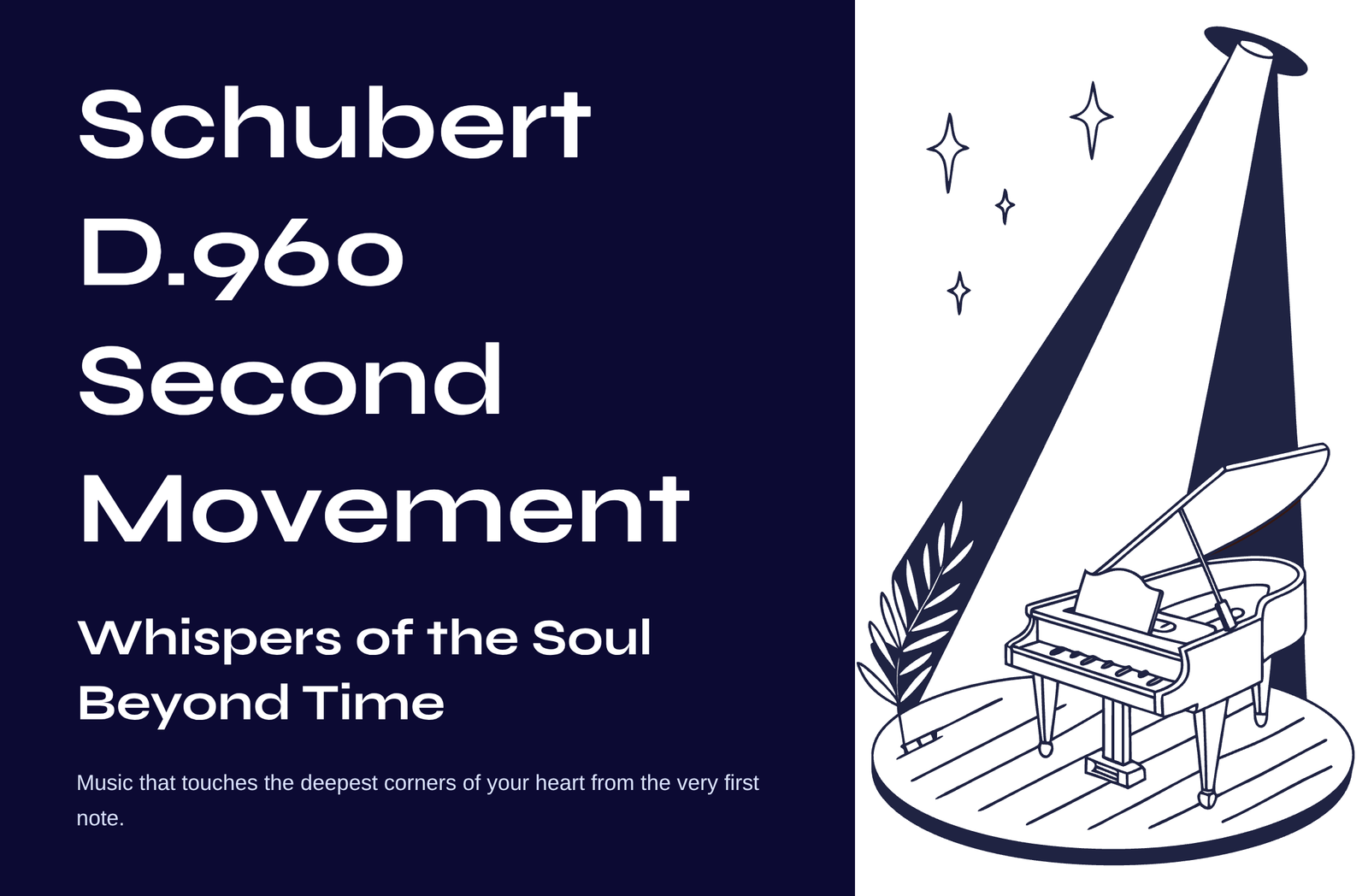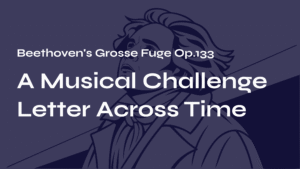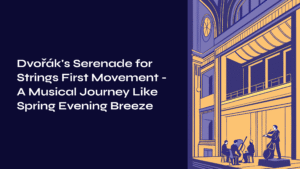Table of Contents
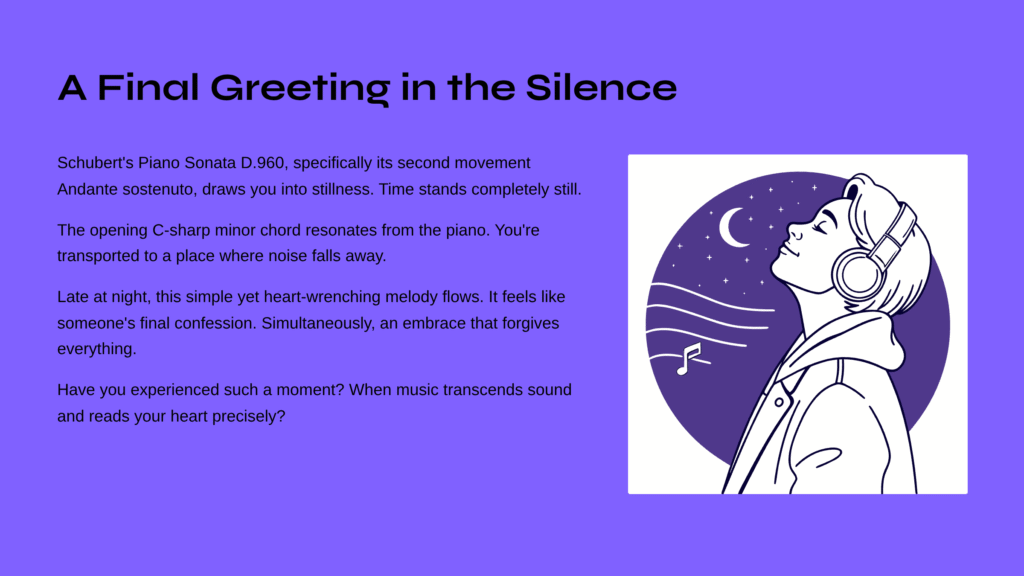
A Final Greeting in the Silence
Some music touches the deepest corners of your heart from the very first note. Schubert’s Piano Sonata D.960, specifically its second movement Andante sostenuto, is exactly that kind of piece. The moment the opening C-sharp minor chord resonates from the piano, you’re drawn into a stillness where time seems to stand completely still.
I still vividly remember the first time I heard this music. It was late at night, after all the world’s noise had fallen asleep, when this simple yet heart-wrenching melody flowed from the piano. It felt like someone’s final confession, and simultaneously like an embrace that forgave everything.
Have you ever experienced such a moment? When music transcends mere sound and feels as if someone has read your heart precisely and translated it into musical notes?
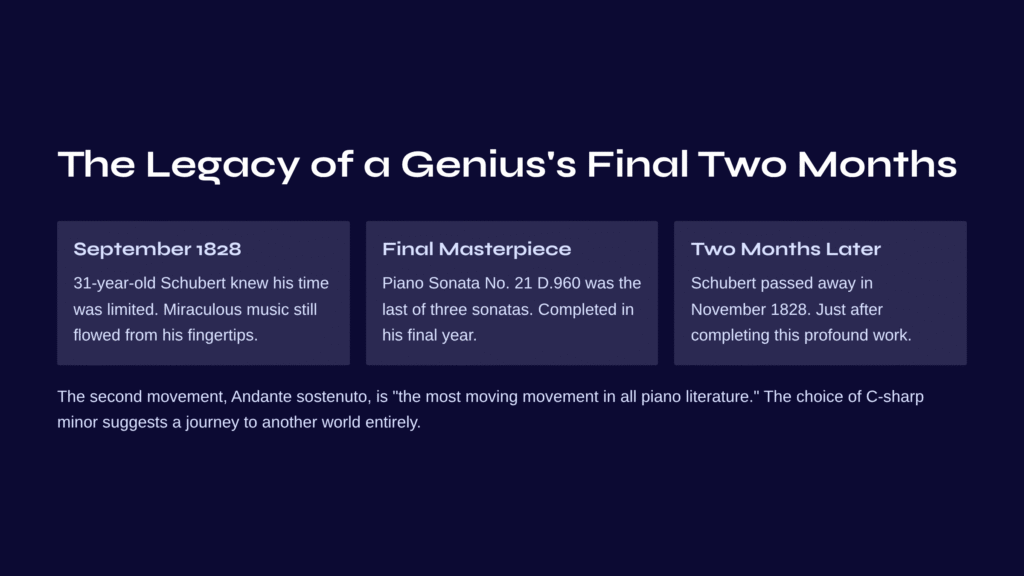
The Legacy of a Genius’s Final Two Months
In September 1828, 31-year-old Franz Schubert knew his remaining time was limited. Though his body had reached its limits due to tertiary syphilis and the toxic side effects of mercury treatment, miraculous music still flowed from his fingertips.
Piano Sonata No. 21 D.960 was the last of three sonatas he completed in his final year. The second movement, Andante sostenuto, is what many music lovers call “the most moving movement in all piano literature.” Schubert passed away just two months after completing this piece, in November 1828.
The choice of C-sharp minor is deeply meaningful. This key is harmonically very distant from the B-flat major of the first movement, as if suggesting a journey to another world entirely. Through this movement, Schubert guides us into a realm of “austere and poignant calm.”
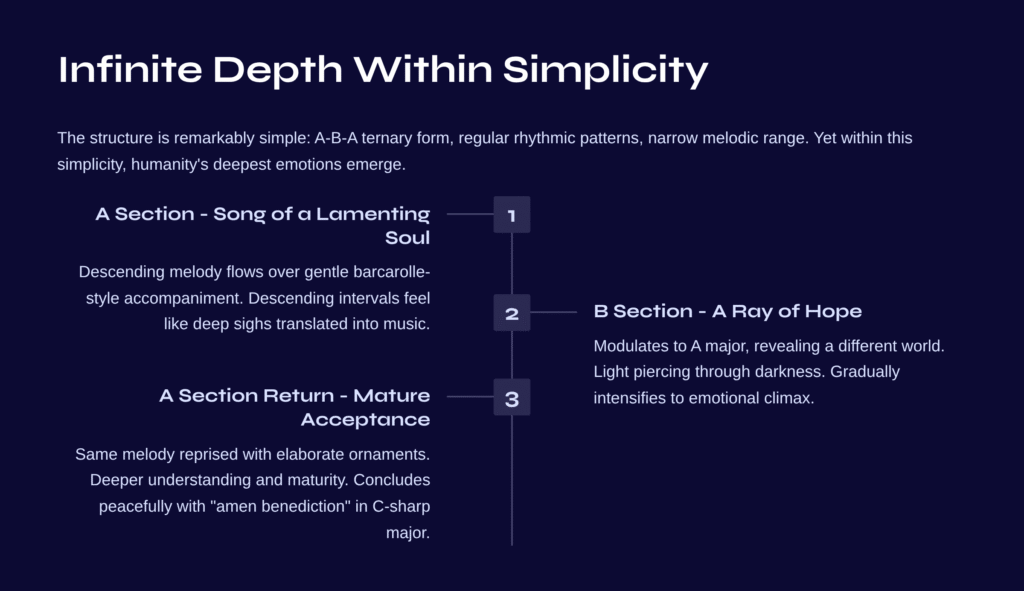
Infinite Depth Within Simplicity
The structure of this movement is remarkably simple: an A-B-A ternary form, regularly repeating rhythmic patterns, and melodies that move within a narrow range. Yet within this simplicity, Schubert embedded humanity’s deepest emotions.
A Section – Song of a Lamenting Soul
The movement opens with a descending melody flowing over a gentle barcarolle-style accompaniment. These descending second intervals feel like deep sighs translated into music. The clockwork-regular rhythm continues in repetition, yet within that repetition lies hypnotic beauty.
B Section – A Ray of Hope
The middle section modulates to A major, suddenly revealing a different world. It’s like a shaft of light piercing through darkness, offering melody that brings comfort and hope. However, this peaceful moment gradually intensifies, reaching an emotional climax through extreme ranges, trills, and fortissimo chords.
A Section Return – Mature Acceptance
When the A section returns, the same melody is reprised with more elaborate ornaments. It’s as if the same story is being told again, but this time with deeper understanding and maturity. Finally, it concludes peacefully with an “amen benediction” in C-sharp major.
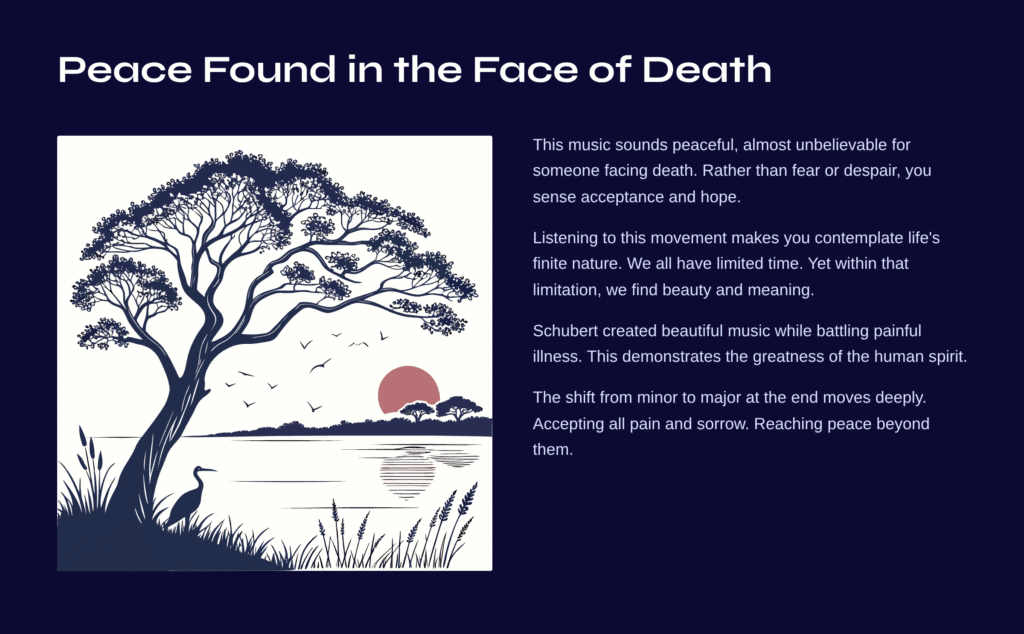
Peace Found in the Face of Death
What’s most remarkable about this music is how peaceful it sounds, almost unbelievable for a piece written by someone facing death. Rather than fear or despair, you sense acceptance, peace, and hope.
Whenever I listen to this movement, I find myself contemplating life’s finite nature. The fact that we all have limited time, yet within that limitation we can still find beauty and meaning. That Schubert could create such beautiful music while battling painful illness seems to demonstrate the greatness of the human spirit.
The moment when the music shifts from minor to major at the end always moves me deeply. It’s the moment of accepting all pain and sorrow and reaching a peace beyond them. It feels like Schubert’s final message of comfort to us all.
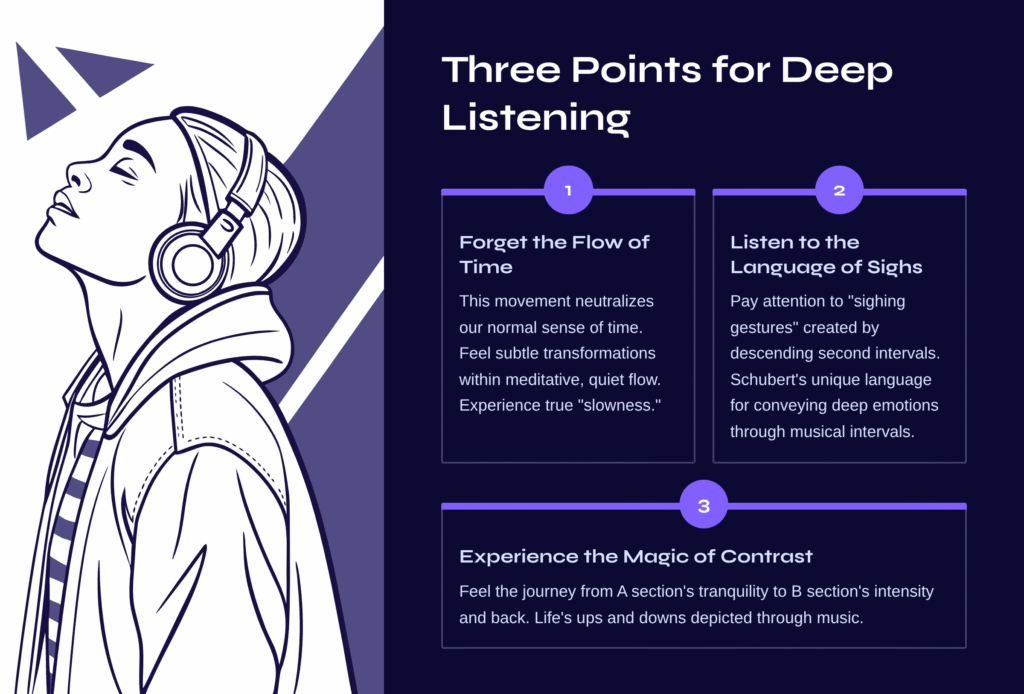
Three Points for Deep Listening
First, forget the flow of time and just listen
This movement neutralizes our normal sense of time. Rather than rapid changes, feel the subtle transformations within a meditative, quiet flow. It’s music that allows modern people to escape their busy daily lives and experience true “slowness.”
Second, listen to the language of sighs
Pay attention to the “sighing gestures” created by the descending second intervals. This expression technique recalls Schubert’s song cycle “Winterreise,” particularly “Der Leiermann” (The Hurdy-Gurdy Man). It’s Schubert’s unique language for conveying deep emotions that words cannot express through the movement of musical intervals.
Third, experience the magic of contrast
Feel with your whole being the journey from the A section’s tranquility to the B section’s intensity and back to serenity again. This dramatic contrast embodies Schubert’s genius in depicting life’s ups and downs through music.
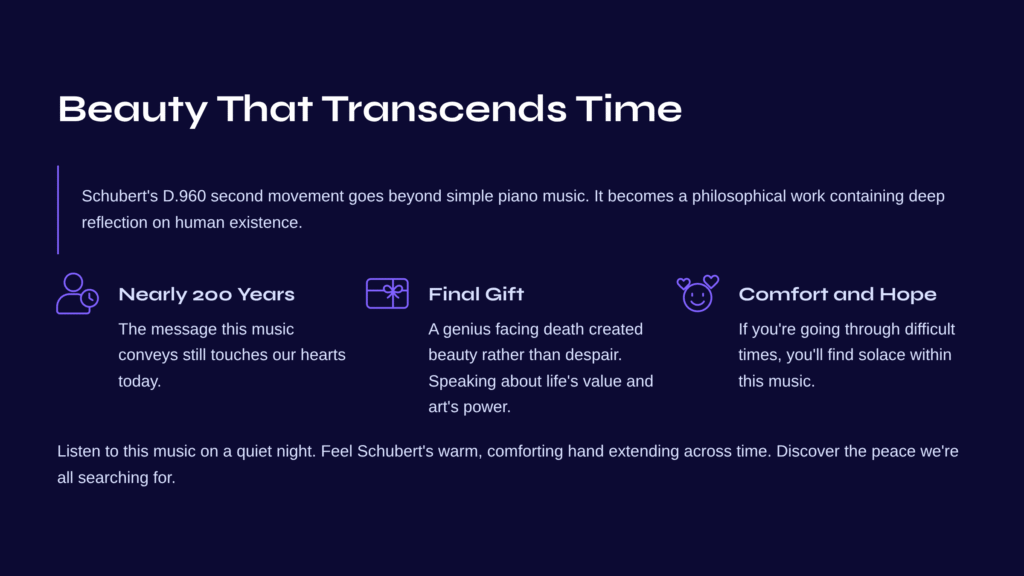
Beauty That Transcends Time
Schubert’s D.960 second movement goes beyond simple piano music to become a philosophical work containing deep reflection on the essence of human existence. Though nearly 200 years have passed, the message this music conveys still touches our hearts.
The final gift from a genius who, even facing death, created beauty rather than despair. It speaks to us about life’s value and the power of art. If you’re going through difficult times or pondering life’s meaning, you’ll find comfort and hope within this music.
Listen to this music on a quiet night, in your own private time. You’ll feel the warm, comforting hand that Schubert extends to you across time. And in that touch, you’ll discover the peace we’re all searching for.
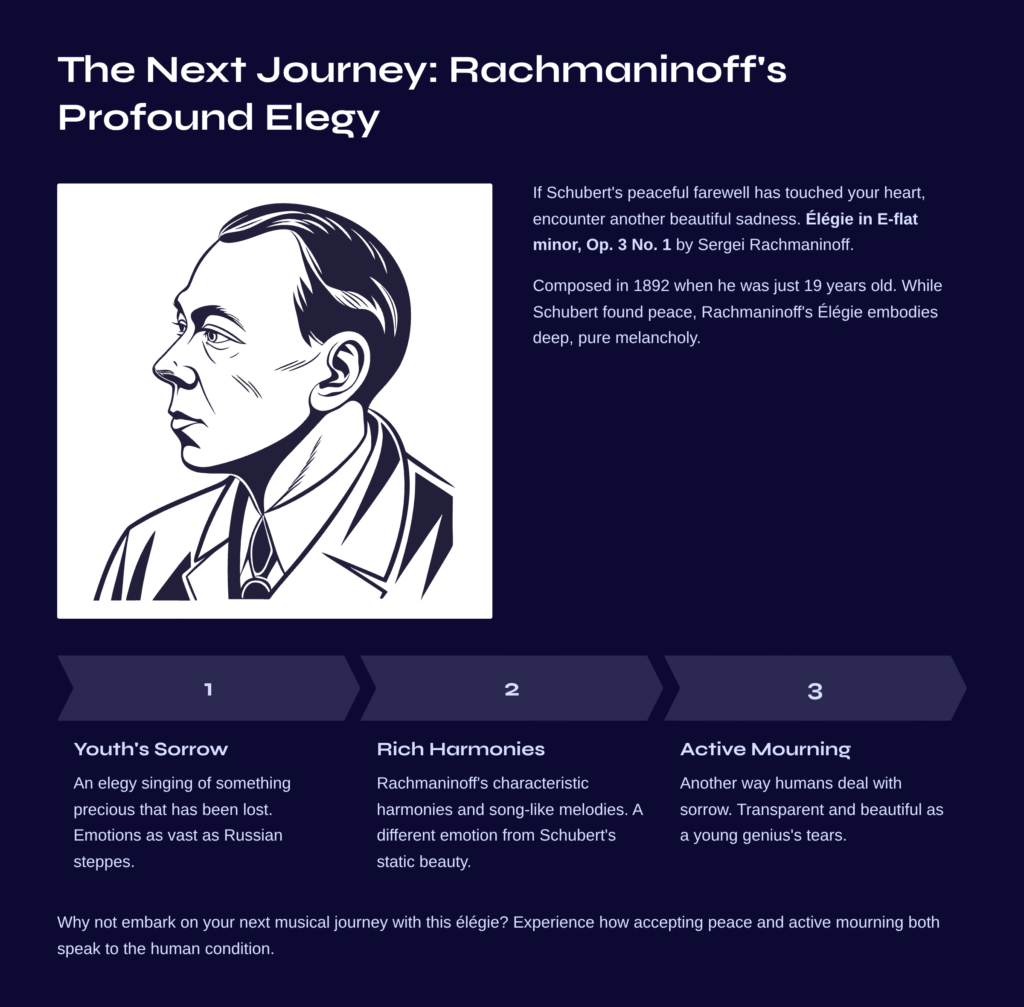
The Next Journey: Rachmaninoff’s Profound Elegy
If Schubert’s peaceful farewell has left a deep impression on your heart, it’s time to encounter another kind of beautiful sadness. I recommend the Élégie in E-flat minor, Op. 3 No. 1 by Russian master Sergei Rachmaninoff (1873-1943), composed in 1892 when he was just 19 years old.
While Schubert found peace in the face of death, Rachmaninoff’s Élégie embodies the deep, pure melancholy felt by youth. True to its title “Élégie,” this piece is an elegy that sings of sorrow for something precious that has been lost.
Though it’s a short piece lasting about 10 minutes, it contains emotions as vast and deep as the Russian steppes. The world created by Rachmaninoff’s characteristic rich harmonies and song-like melodies will offer a different kind of emotion from Schubert’s static beauty.
Particularly after experiencing Schubert’s accepting peace, Rachmaninoff’s active mourning shows us another way humans deal with sorrow. Why not embark on your next musical journey with this élégie, as transparent and beautiful as the tears of a young genius?
